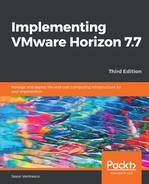UEM is enabled at the client level using AD group policy objects, which are provided in the XML-based GPO template (ADMX) format. Six templates are provided by default for the following UEM components:
- VMware UEM FlexEngine (VMware UEM FlexEngine.admx)—used to enable UEM at the client level
- VMware UEM Helpdesk Support Tool (VMware UEM Helpdesk Support Tool.admx)—used to configure the UEM Helpdesk Support Tool, which provides for the management of UEM profile archives
- VMware UEM Management Console (VMware UEM Management Console.admx)—used to automatically configure the UEM environment settings in the management console, or to lock down what items the target users can access
- VMware UEM SyncTool - Computer (VMware UEM SyncTool COMPUTER.admx)—used to configure UEM SyncTool, which is designed to sync UEM profiles to physical clients who have only intermittent connectivity to the UEM shares; this GPO template is for AD computer objects
- VMware UEM SyncTool - User (VMware UEM SyncTool USER.admx)—same function as the UEM SyncTool—computer policy object, but for AD user objects
- VMware UEM (VMware UEM.admx)—Root UEM GPO folder object for the AD Group Policy Management Console; contains no configurable policies
The VMware UEM FlexEngine GPO template is the only one needed to enable UEM, and the only UEM GPO template we will use in this chapter. For information about the remaining policy templates and the features they enable, consult the VMware UEM documentation (https://www.vmware.com/support/pubs/uem-pubs.html).
Prior to performing the examples required in this chapter, the UEM ADMX files and their associated en-US directory were copied to the replicated PolicyDefinitions folder on the domain controller, located at c:windowssysvoldomainPoliciesPolicyDefinitions, which ensures that they will be replicated to and available on all domain controllers in the domain.
